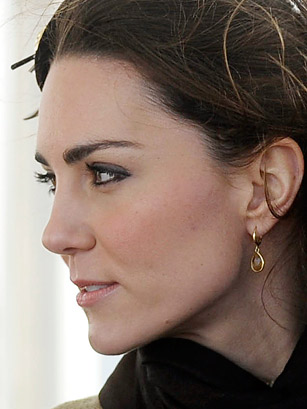
Every Windsor is a draw, even the minor players. So for Queen Elizabeth's Nov. 28 reception for the media — held in anticipation of the 2012 Diamond Jubilee, her 60th year on the throne — palace functionaries set about organizing their 350 guests into manageable constellations along the elegant expanse of the Picture Gallery and in the drawing rooms at either side. The place was lousy with royalty — not only the monarch and her sardonic consort but also Prince Charles, Camilla and a brace of cousins. But then came word that the Duke and Duchess of Cambridge were holding court in the Blue Drawing Room, and the revelers swirled and regrouped like iron filings exposed to a powerful magnet. Kate — the single syllable now a global brand — is bigger box office than the rest of her in-laws combined.
Chin-stroking editors of national newspapers, lofty columnists and feared TV interrogators elbowed one another for the chance to inspect the 29-year-old's flawless skin and abundant locks, to find out if she is more striking in person (she is) and to hear her speak. And speak she did, a touch hesitantly, making diplomatic small talk about her strange new life. She hasn't been to Buckingham Palace much since the wedding. She hasn't seen her family much since the wedding. She is proud of her husband. Prominent intellectuals and public figures crowded around to catch these anodyne words. "I've never seen such a bunfight," said one despairing palace official.
For the older Windsors, the spectacle may have brought back uncomfortable memories. Exactly three decades ago, they watched a glamorous outsider become the main attraction. Some of their number appeared a little jealous. Yet by all accounts, the royals also appreciated the renewed sense of relevance that Diana Spencer brought to their musty enterprise. By the time they recognized the strength of her gravitational pull, she had almost dislodged the centuries-old institution from its axis.
Support for the royals held steady in the aftermath of Diana's death, but not even the most ardent of monarchists predicted the excitement around her son's marriage, which brought London to a standstill and snared global audiences in the millions — or billions, according to some estimates. From a news perspective the royal wedding seems like 2011's biggest anachronism. This was a year when — from Tunisia and Egypt to the U.S. and, yes, the U.K. too — throngs came together in rage to topple leaders and challenge institutions, not cheer them.
Is Kate's story a last gasp of nostalgia, a feel-good movie for the bleakest of times? Or a cautionary tale for anyone who dared to dream that the struggles of the 20th century would build a more equal world in the 21st? In marrying the second in the line of succession, the newly minted princess has accepted a mission riven with apparent contradictions. She's expected to uphold tradition while bringing modernity to the monarchy, and to reinforce a system based on birthright while proving that a commoner can cut it as a royal. Though she's the first royal bride to have earned a degree, she is unlikely to build a career or even hold down a paying job. Her primary function is to bear children and prepare for the eventuality of one day becoming Queen. Any other duties, as defined by palace conventions, are largely silent or scripted, symbolic and ceremonial. No wonder her words — any words — have such currency.
Kate has given only one interview of any length: with Prince William at her side, after the announcement of their engagement. In the seven months since her wedding, she has kept her thoughts to herself and abided by palace conventions. There are signs that she intends to continue to do so. The head that wears the crown may lie a little easier than in the Diana years.
Yet Diana didn't join the royal family to undermine it, nor could she have anticipated becoming the most famous woman of her age. An avatar of the Establishment, she became its nemesis. A dutiful bride, she morphed into a feminist icon. The pressures of palace life and the shambles of her marriage were the catalysts for this change. Kate has also been catapulted to relentless, inescapable celebrity. She finds herself a role model whose most pressing task is to define the nature and meaning of the role. If she becomes as popular as Diana, her choices may help the monarchy thrive or bring it to its knees. Whatever she decides — however she goes about the business of being royal — Britain's second most famous princess is already being watched and emulated across the world. We have entered the era of the copy-Kate.
Keeping Her Head
St. James's palace was built for Henry VIII, and the initials HA, entwined in a lover's knot above a couple of the remaining Tudor fireplaces, celebrate his passion for Anne Boleyn, the commoner who became his second wife. The King later ordered his beloved's beheading for treason, though in all probability she was guilty of nothing more treasonable than failing to give him a male heir. It is in this palace of sorrows, in rooms overlooking a courtyard, that Kate has been learning the regal ropes.